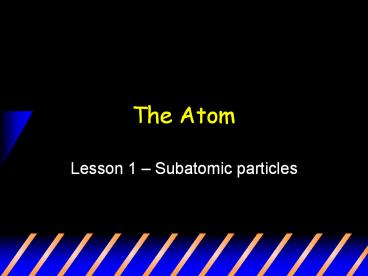The Atom PowerPoint PPT Presentation
Title: The Atom
1
The Atom
- Lesson 1 Subatomic particles
2
What is an atom?
- Atom the smallest unit of matter that retains
the identity of the substance - An atom is made of protons, neutrons, and
electrons
3
Atomic Structure
- Atoms are composed of 2 regions
- Nucleus the center of the atom that contains
the mass of the atom - Electron cloud region that surrounds the
nucleus that contains most of the space in the
atom
Nucleus
Electron Cloud
4
Whats in the Nucleus?
- The nucleus contains 2 of the 3 subatomic
particles - Protons positively charged subatomic particles(
mass of 1 amu) - Neutrons neutrally charged subatomic particles
(mass of 1 amu)
5
Whats in the Electron Cloud?
- The 3rd subatomic particle resides outside of the
nucleus in the electron cloud - Electron the subatomic particle with a negative
charge and relatively no mass
6
Parts of an atom
Subatomic Particles Charge Mass (amu) Location
Proton Positive () 1 Nucleus
Neutron No charge 1 Nucleus
Electron Negative(-) 1/1840 Electron cloud
7
How do these particles interact?
- Protons and neutrons are compacted in the tiny
positively charged nucleus accounting for most of
the mass of the atom but barely any volume. - The negatively charged electrons are small and
have a relatively small mass but occupy 99 of
the volume of the atom.
8
How do the subatomic particles balance each other?
- In a neutral atom
- The protons the electrons
- If 20 protons are present in an atom then 20
electrons are there to balance the overall charge
of the atomthese atoms are neutral, meaning they
have an overall charge of ZERO! - The neutrons have no charge therefore they do
not have to equal the number of protons or
electrons
9
How do we know the number of subatomic particles
in an atom?
- Atomic number (Z) this number indicates the
number of protons in an atom - Ex Hydrogens atomic number is 1
- So hydrogen has 1 proton
- Ex Carbons atomic number is 6
- So carbon has 6 protons
- The number of protons identifies the atom as a
specific element. - Ex. 2 protons He, 29 protons Cu
10
How do we know the number of subatomic particles
in an atom?
- Mass number (A) the number of protons and
neutrons in the nucleus - Ex hydrogen can have a mass number of 3.
- Since it has 1 proton it must have 2 neutrons
- of neutrons mass - atomic A - Z
11
What does the information on the Periodic Table
tell me?
- 1
- H
- 1.008
Atomic Number (Z) of protons
Elemental Symbol one or two letters, first is
always Upper case, second is lower case
Average Atomic Mass Weighted Average of Protons
Neutrons combinations Note This is not the
Mass Number!
12
Determining the number of protons and neutrons
- Li has a mass number of 7 and an atomic number of
3 - Protons 3 (same as atomic )
- Neutrons 7-3 4 (mass - atomic )
- Ne has a mass number of 20 and an atomic number
of 10 - Protons 10
- Neutrons 20 - 10 10
- Other way to write elements Neon-20
Mass Number
13
What about the electrons?
- In a neutral atom, the electrons are equal to the
number of protons - So e- p atomic
- Ex He has a mass of 4 and an atomic of 2
- p 2
- no 2
- e- 2
14
Determine the number of subatomic particles in
the following neutral atoms
- Cl has a mass of 35 and an atomic of 17
- p 17, no 18, e- 17
- K has a mass of 39 and an atomic of 19
- P 19, no 20 e- 19

